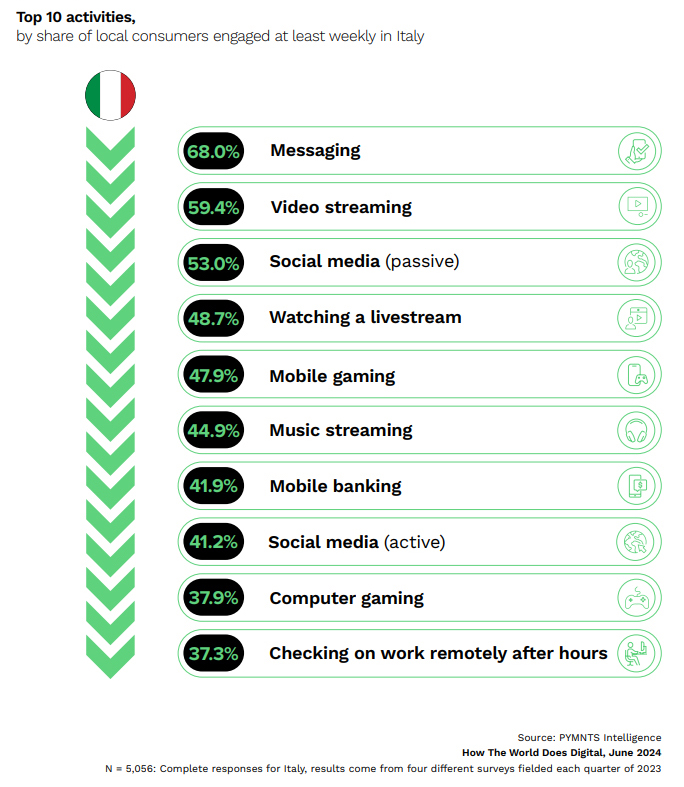
While the Colosseum evokes gladiatorial battles, and Michelangelo’s Sistine Chapel frescoes hold timeless beauty, modern Italy is embracing the digital age.
Today’s Italians are increasingly turning to mobile wallets and online shopping, showcasing a blend of tradition and digital innovation.
In PYMNTS Intelligence’s “How the World Does Digital” report, Italy ranked in the top half of 11 surveyed countries, including European neighbors Spain, France, Germany, the Netherlands, and the United Kingdom. The survey illustrated the digital habits of 817 million consumers in the 11 countries, revealing a landscape of digital engagement. It evaluated digital behaviors across 11 key aspects of digital engagement, including banking, shopping, communication and entertainment.
Italy, the third-largest European Union economy by gross domestic product, featured a digitally active population supported by widespread broadband and extensive mobile network coverage.

According to the report, 88% of Italians have access to high-speed broadband, enabling a range of online activities. Mobile networks are robust, with nearly everyone able to access 4G and 40% of Italians able to access 5G services. Meanwhile, messaging applications are popular, with more than 68% of the population engaging weekly. Video streaming is also widely embraced, with 59.4% of Italians favoring digital entertainment options.
Almost all Italian adults owned smartphones by 2022, but only 83% possessed debit cards, a relatively lower figure compared to other developed nations. This suggests a preference for cash transactions or potential barriers to accessing financial services.
Italy is competitively positioned among the 11 countries surveyed, ranking fifth overall in digital engagement with an average of 280 activity days per month.
Generationally, Generation Z exhibited the highest digital engagement with 435 activity days, while baby boomers lagged with 178 days.
Similar to Spain, income seems to play a smaller role here compared to other countries. High-income earners led in total activity days with 288, followed by middle-income earners at 285 days, and low-income earners at 264 days.
Italy performed above the EU average in having access to electronic health records. As of 2023, 82.7% of citizens have access to electronic health records, compared to the EU average of 79.1%. This service is available nationwide and saw an increase in adoption of 15.9% in 2023.
Despite these strengths, three key challenges remain.
Cloud and AI adoption by businesses: Only 5% of Italian companies used cloud technologies, compared to the EU average of 8%. Additionally, Italian businesses struggled with artificial intelligence adoption, falling below the EU average.
Scaling up startups: Building successful tech companies in Italy proved difficult. The ecosystem lacked support, and venture capital investment remained limited. This was reflected in the low number of unicorns (startups valued at over $1 billion). With only seven unicorns in 2023, Italy represented less than 3% of the EU’s total.
Digital skills gap: Only 45.8% of Italy’s population possessed basic digital skills, falling below the EU average of 55.6%. This shortfall existed across all age groups and has shown limited improvement in recent years.
Although it showed a respectable fifth-place ranking, Italy is committed to elevating its digital transformation position, evidenced by its $3 billion investment in this area, a figure expected to reach $3.83 billion by 2029.